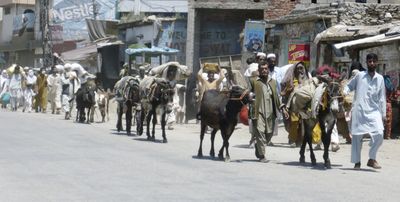Toe-to-toe showdown may be near for Taliban, army
In tactical shift, militants remain in Pakistan city

ISLAMABAD, Pakistan – Taliban insurgents in Pakistan’s Swat Valley may be preparing to fight the army on the streets of the scenic district’s main city, as soldiers and guerrillas adopt surprising conventional war tactics.
The army appears poised to enter Mingora city, lifting a curfew Friday to allow thousands of its remaining residents to flee. Whereas classic guerrillas would melt away into the hills, the Taliban in Mingora, puzzlingly, seemed to be waiting to take on the advancing troops.
The Pakistan army itself hasn’t committed the number of troops that experts think would be required for counterinsurgency operations, and the high level of Taliban deaths the military has claimed would be unlikely if the Islamic extremists were using guerrilla tactics.
Officials in Washington, which has backed the Swat offensive, fear that key ally Pakistan risks excessive civilian casualties with its current approach, as thousands of residents remain trapped in the valley.
“If they (the Taliban) try to fight the army in Mingora or some other town, they don’t stand a chance against the superior numbers which the army can assemble and the firepower the army can deliver,” said analyst Javed Husain, a retired army brigadier who served in Pakistan’s Special Services Group commando unit.
So far, the nine-day-old army offensive in Swat – which is 100 miles from Islamabad, Pakistan’s capital – hasn’t moved into the valley’s towns. Those who managed to escape Mingora, where five headless bodies were found this week, warned that the army would face tough resistance from deeply entrenched Taliban in the city.
Shaukat Saleem, a Mingora resident who escaped from Swat on Friday, said the Taliban had blocked roads in the city with trees and boulders. They’ve mined the streets, dug trenches, made bunkers and occupied many civilian homes, he said. He said that he saw “lots” of Taliban as he was leaving the city, who stopped him for questioning at 10 to 12 of their checkpoints.
“Mingora is completely in Taliban hands,” said Saleem, who’s now a refugee at the Jalozai camp near Peshawar with his wife and son. “On the streets you only see Taliban and stray dogs.”
The army estimated earlier this week that as many as 200,000 civilians were still in Mingora, and it was unknown how many remained there after Friday’s exodus. The army said that it had cleared the area that leads to Mingora from the south as far as Udigram, a village on the outskirts of the city.
“We allowed the civilians to move out of Mingora city. We relaxed the curfew,” said Maj. Gen. Athar Abbas, the army’s chief spokesman.
Abbas declined to comment on the timing of a Mingora operation and whether the army would wait for all the residents to evacuate. It seems likely that thousands of them remain in the city, leading to fears that the Taliban might use them as “human shields.”